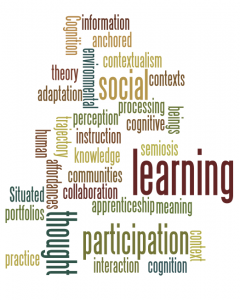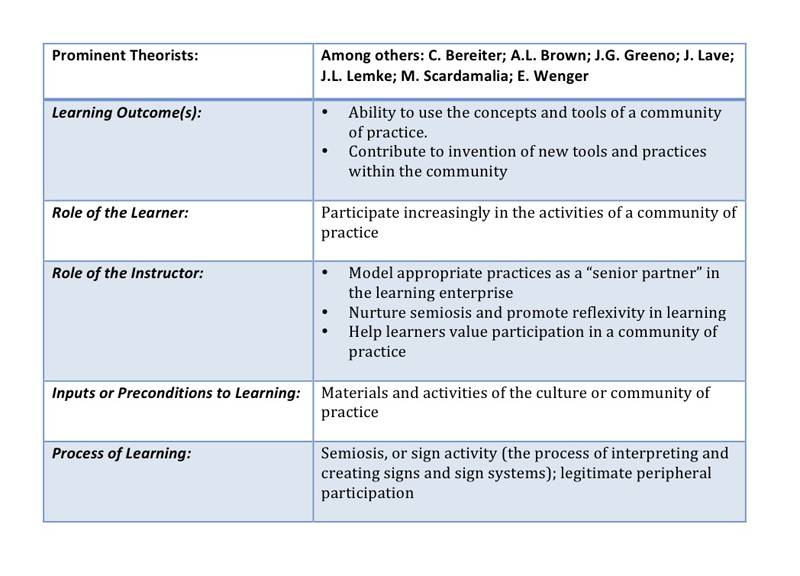Key People
Jean Lave – social anthropologist and social learning theorist
Etienne Wenger – educational theorist and practitioner
John Seely Brown – researcher in organizational studies
Allan Collins – cognitive and education scientist
Paul Duguid – professor and education researcher
Core Concepts:
- knowledge and practical activity are inseparable
- teach concepts to students in contexts that they are familiar with and will be applying to.
- learning involves the community and relies on its social network within
Situated Cognition Theory Matrix (Driscoll 2005, p. 182)
Key Definitions
Cognitive apprenticeship – a learning approach that embeds learning in activity. Both social and physical contexts are used.
Enculturation – the cultural practices of a social group. Learning the requirements (behaviour and values) of the culture around them.
Authentic activity – ordinary practices of the culture. Activities that happen in the real world and that students are learning and using their knowledge towards.
Cognitive Apprenticeship
In their article, Brown, Collins, and Duguid argue that knowledge and skills cannot be taught independently from the real-life settings that they will be used in. Brown et al. (1989) base their argument on findings from past cognitive studies.
6 Processes in Cognitive Apprentice:
Modeling – when an expert (i.e. a teacher) is demonstrating to a novice (i.e. a student)
Coaching – when an expert observes a novice and provides feedback to help sculpt the novice
Scaffolding – strategies used to support student learning
Articulation – when a novice demonstrates their knowledge and thoughts (inquiry)
Reflection – the process through which a novice analyzes their performances; comparing performances from the onset to present time
Exploration – the process of getting a novice to problem solve and explore further with learned knowledge
John Abbott is an advocate of Cognitive Apprenticeship. In the following video clip, Abbotts speaks on the modeling aspect of the expert to novice relationship and learning.
Practical Understandings
Molly, the cat, has been eating too much and gained a bit of weight. She is going on a diet to trim herself down. Molly attends a healthy diet class at the local pet store and is told to reduce her meal portion. She is given instructions to have 3/4th of 1/3rd of a cat food can. At first, Molly is confused with the fractions and math involved with her diet plan. She can’t seem to apply the math she learned in school to figuring out the portion size of her meal. Molly decides to stop attempting the math equation on paper and tries to figure out the instructions by following the mathematical steps with an opened can of food. First, she scoops 1/3rd of food out of the can. Next, she takes 3/4th from the scooped portion. “Ah-ha! I’ve figured it out. The math wasn’t that difficult after all, but now I’m left with a tiny amount food…”
Molly, the cat, is doing her math homework. She can easily do the math equations on paper. However, if you put her in another context, she has difficulty applying the same math skills.
Molly, the cat, is studying her vocabulary. She is on to the C’s. Later that day while on a walk, she thought she would practice her vocabulary.
Summary of Brown, Collins, & Duguid (1989) on Situated Cognition and the Culture of Learning
Brown et al. (1989) argue that learning cannot be abstract and that learning needs to occur within the context of real cultures around a student. They believe that how information is learned and how it will be applied must be together. Therefore, situations are created when knowledge is produced through activity. They argue that activity and situations are connected with learning and cognition. Brown et al. (1989) describe several learning approaches to show situated learning and its effect on cognition. They first describe the problem of learning words in language with a dictionary. The learner cannot fully understand the meaning of a word simply by looking up its definition. They will need to be able to use the word in their own context and world. Therefore, information and learning cannot be abstract from the real life application of it.
Another example regards the different uses of tools. The culture and environment of where the tool will be used will also shape how it should be taught to someone. According to Brown et al. (1989), “activity, concept, and culture are interdependent.” Students often are taught a concept outside of its use in culture. They don’t get an opportunity to engage their learning within the dominant culture around them (Brown et al, p. 4). The article puts emphasis on students learning in authentic activities.
The authors also discuss cognitive apprenticeship with the example of Schoenfeld’s teaching of problem solving. Schoenfeld taught his students how to see the world mathematically and with mathematical tools. His classes would collaboratively work together to solve math problems, such as “The Magic Square.” Another example is of an elementary school teacher in Lampart (1986) who teaches her students math by using their everyday language. Lampart’s approach starts by introducing a new math concept with a familiar activity. Then, students create stories for the math problems and finally students are introduced to a standard algorithm. By the last stage, students should see that the math algorithm has both meaning and purpose in their community. The difference between Schoenfeld and Lampart’s approaches differ in that Schoenfeld’s emphasizes students’ exposure to “authentic ways of thinking of a culture and its conceptual viewpoint.” In Schoenfeld classes, “social network within the culture helps them [the students] develop their own language and showcases the process of enculturation.” Brown et al. (1989) suggest that the theory of knowledge is still developing as studies are showing that activity and enculturation is important to learning.
References
Abbott, J. (n.d.). Let me ‘do’ and I understand: Cognitive apprenticeship [Video file]. Retrieved October 20, 2011, from http://youtu.be/BnbmLHgQWqQ
Allan Collins photo. Retrieved October 26, 2011, from: http://thinkertools.org/Pages/who.html
Brill, J. M.. (2001). Situated Cognition. In M. Orey (Ed.), Emerging perspectives on learning, teaching, and technology. Retrieved October 24, 2011, from http://projects.coe.uga.edu/epltt/
Brown, Collins, & Duguid (1989). Situated Cognition and the culture of learning. Educational Researcher, 18, 32-42. Retrieved October 25, 2011, from: http://links.jstor.org/sici?sici=0013-189X%28198901%2F02%2918%3A1%3C32%3ASCATCO%3E2.0.CO%3B2-2
Cooper, S. Continuing Education, Home Study CE Courses for Massage, Asian Bodywork, & Acupuncture. Jean Lave biography. Retrieved October 26, 2011, from: http://www.lifecircles-inc.com/Learningtheories/constructivism/Lave.html
Etienne Wenger Photo. Retrieved October 26, 2011, from: http://www.ewenger.com/
Jean Lave Photo. Retrieved October 26, 2011, from: http://unt.unice.fr/uoh/learn_teach_FL/affiche_theorie.php?id_theoricien=49&connexion=?=eng&id_theorie=4&id_categorie=3
John Seely Brown Ohoto. Retrieved October 26, 2011, from: http://www.johnseelybrown.com/
Model of Cognitive Apprenticeship. Retrieved October 31, 2011, from: http://projects.coe.uga.edu/epltt/index.php?title=Cognitive_Apprenticeship
Paul Duguid Photo. Retrieved October 26, 2011, from: http://www.ischool.berkeley.edu/people/faculty/paulduguid







